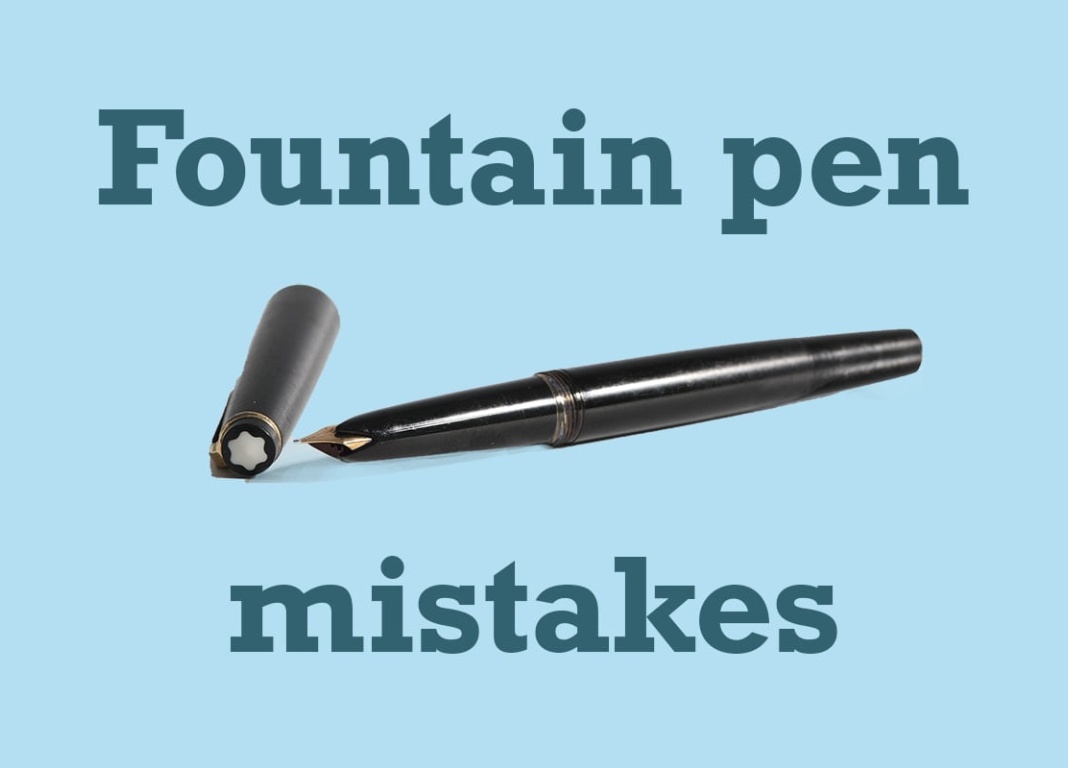
- Mistake one - not using your pen
- Mistake two - using the wrong paper
- Mistake three - pressing too hard
- Mistake four - using the wrong ink
- Mistake five - not cleaning your pen
- Mistake six - dropping on the nib
- Mistake seven - not keeping the nib upright
It’ll come as no surprise that we’re big fans of fountain pens here at Vintage Cash Cow. Biros are great and all, but we really enjoy the increased feeling of being connected with what you’re writing that a fountain pen creates. Not to mention the hundreds of different inks you can get - we experiment from week to week with different colours. Emerald green is a company favourite.With all that being said, it’s fair to say that fountain pens aren't quite as simple as a Biro or the humble pencil. There’s a few things you can get wrong, and a few things that you need to remember if you’re going to keep yours in tip-top condition.We recently discovered the absolute scholars over at the Gentleman’s Gazette - an incredible website and Youtube channel dedicated to gentlemanly living as well as the pursuit of authentic living. In particular, we loved this video about common fountain pen mistakes and thought it was just perfect for sharing with our readers, so we transcribed it.
To summarise, here are the top seven fountain pen mistakes:
- Mistake one - not using your pen
- Mistake two - using the wrong paper
- Mistake three - pressing too hard
- Mistake four - using the wrong ink
- Mistake five - not cleaning your pen
- Mistake six - dropping on the nib
- Mistake seven - not keeping the nib upright
Have you ever wondered why some people write with a fountain pen rather than with a ballpoint pen? Actually, it's because they have a bunch of advantages. At the same time, you can make a lot of mistakes with them, especially when you start out. In today's video, we talk about the seven fountain pen mistakes that most beginners make and how you can avoid them.Unlike a ballpoint pen, fountain pens can cost hundreds or thousands of dollars and they are an accessory that enhances your handwriting and make it more unique. At the same time, they demand a certain amount of care and attention because they use ink and a nib. In the US, most people aren't exposed to fountain pens unless they actively pursue them and if they do, however, most people fall in love with them and always prefer them over regular pens. When you start out, you are very prone to make those mistakes and all the people who I've met who just started the fountain pen when they were an adult made those as well so let's dive right in.
Mistake one - not using your pen
The biggest mistake is not using a fountain pen at all. Even if you own it, you may just have it in your desk drawer and it never sees the light of day. In my opinion a huge advantage of a fountain pen is your signature. Not only does it make it look more sophisticated, but it's actually much harder to fake because the lines vary in thickness depending on the pressure you put onto the nib. Of course, it's easy to forget about handwriting in a digital world. You can take notes with your phone, you can use Google Home Assistant or Alexa, but at the same time it has been proven that writing down things by hand, especially if you're taking notes, enhances your memory and you learn faster. As Murphy's Law have it, you never have a pen when you need it, so it really pays to make a fountain pen part of your everyday carry, so you always have it handy when you need it. To learn more about everyday carry and what other items you can carry with you, please check out this video here.
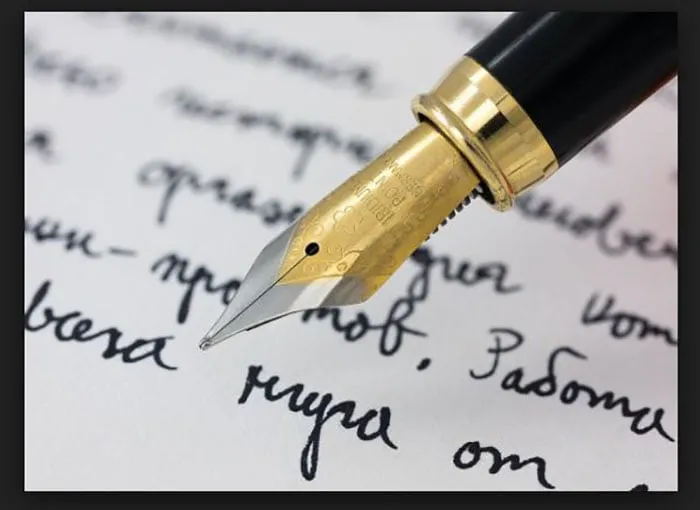
Mistake two - using the wrong paper
Mistake two is using the wrong paper. Because of the nib and the ink feed, you get more ink onto the paper. Now, the most regular paper is very thin and sometimes flimsy and when you use a fountain pen you will encounter something called bleeding. Basically, it's just ink bleeding into the paper leaving a very undefined line that doesn't look as nice as if you write with the same fountain pen on a thicker paper that absorbs the ink better. So, instead, go with a slightly thicker card stock or go with fountain pen paper, which hardly costs more at all, but it's specifically made for fountain pen ink. If you don't want to bother about the kind of paper you use, I suggest you get an extra fine or a fine nib, because with those you get less ink on the paper and it will look good no matter what paper you use. That being said, if you write a note to someone, they always feel extra special if it comes on a thicker card stock or even a cotton paper because it's just a wonderful experience.
Mistake three - pressing too hard
The third mistake most beginners make is pushing too hard on the nib. If you have a regular ballpoint pen or a roller ball, you can really push hard, even push holes into your paper. Now with a fountain pen you can also add pressure and the more pressure you add, the wider your pen stroke gets. That can be really nice for a signature or if you want to get a calligraphy effect when you write. Now with nibs, you have to pay a little more attention because they are split in the middle so the ink can get to the paper and if you push too hard, you may damage or break the nib and then you'll have to exchange it. Also, if you push too hard, it scratches on the paper, it tires out your hand and it's just hard on the paper as well as the pen. In general, I say a softer touch is better. When you want to write long letters, it pays to have a pen that's slightly heavier, but not too heavy so you can just let it glide over the paper when you write something without having to push on it very forcefully.
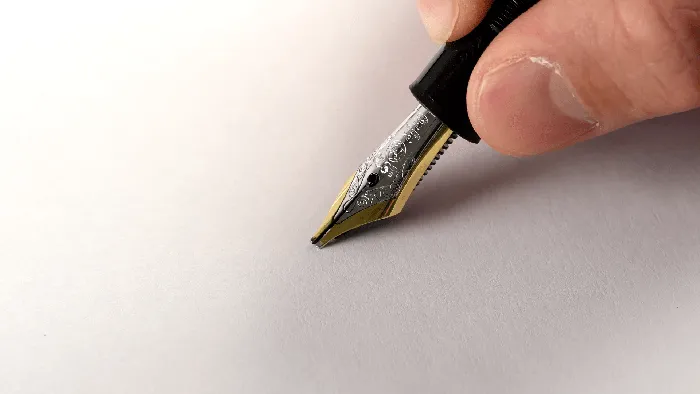
Mistake four - using the wrong ink
The fourth most common fountain pen mistake most people make is using the wrong ink. When you start out, you might think that all ink is alike and you can just buy the cheapest one out there and it'll do a good job. Unfortunately, that's not the case. If you have calligraphy pens, they use a different ink. If you have a fountain pen, you should always go with a specific fountain pen ink. Why, basically they have a different chemical composition that is best for fountain pens because if you get something that is too thick and it dries too quickly, it will clog up your fountain pen and you'll have to constantly clean it. The great part about fountain pen ink is that it comes in hundreds of different colors and it's a great way to express your personality through your ink.For example, I usually have a really dark green ink which is still contrasting on white paper but, at the same time, it's different to royal blue ink, which is probably the number one sold color in the world today. So if you choose a special color, be it your favorite color or maybe the color of the logo of your company, you really underline the whole message, make it unique and special and even harder to fake.If you have a fountain pen that you don't use a lot, you leave it in the drawer, or you only use it for signatures, chances are that the ink on the inside of the fountain pen will dry in and then it won't start when you want to write. If that sounds like you, I suggest to look for a specific ink that is supposed to not dry as quickly and that way you don't have to clean your pen and it's more reliable at the few times you actually use it.
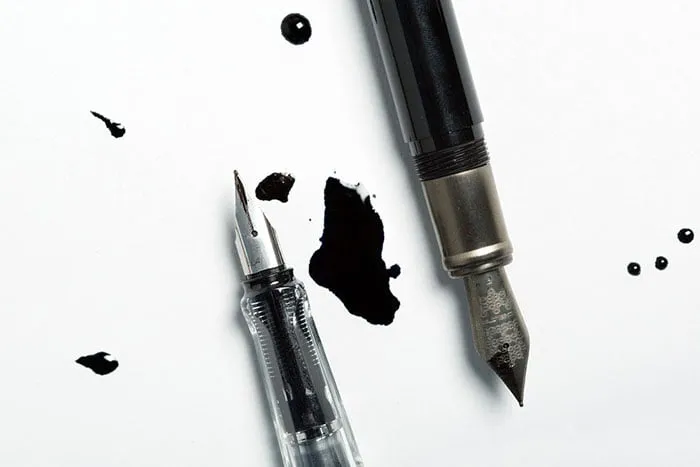
Mistake five - not cleaning your pen
The fifth mistake is not cleaning your pen when it has dried on the inside. Generally, if you keep running a pen and you use high-quality fountain pen ink, chances are you hardly even, maybe never, have to clean your fountain pen. Over time, however, there may be dust or something that's clogged up and then it's time to clean your pen. So how do you do it? Basically there are two ways. One, the simple way is to simply drop your entire pen in water. If it has several parts that you can take apart, take it apart. Try to let it soak in so the dry spots can soak up and then put it all together and see if it writes again.If that's not the case, you may want to use a little toothbrush, maybe you want to blow water from the bottom part through the ink feed throughout the nib just to make sure it's not clogged up.Definitely only use water to clean your fountain pen and don't use alcohol or acetone as they may damage the pen. That being said, the second and best way to clean a fountain pen is to use an ultrasonic cleanser. It's very gentle, it works with water and sound waves that make the parts vibrate and thus clean them. You can use it for jewelry or all kinds of other parts, even for clothes if your cleaner is large enough. All you do is simply add cold water to your ultrasonic cleanser, you immerse the pen on the inside, maybe you make sure that you get the water into the inside chamber, if it's a piston filler or you just fill it up with water and take everything apart so the water can reach all the parts that are dry and dirty.Keep in mind, an ultrasonic cleanser will heat up the water and in combination with the vibrations can cause, especially older pens that are made of materials like celluloid to actually expand. In fact, I once ruined an old Mont Blanc Meisterstuck fountain pen with the casing of a celluloid because it had metal parts on the inside that came up and formed a bump. Now I can still use the pen, however, for collectors it lost basically all of its value. So keep that in mind and always take a look. Shorter is always better, let it run for five minutes rather than 10, take a look, see where it's at. Maybe it's already clean so you can just take it out.
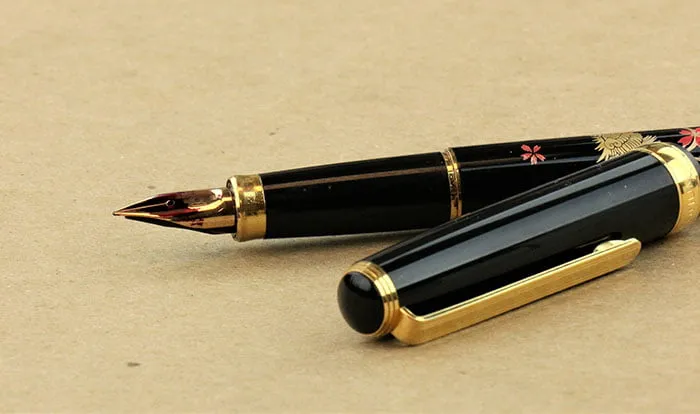
Mistake six - dropping on the nib
The sixth mistake is dropping a fountain pen on the nib. I know you don't drop your pens intentionally, but unlike with a ballpoint pen, if it falls right on the tip of the nib, it may break or it may deform and then it's time to have the nib replaced. If you just have a steel nib, it's actually quite inexpensive. If you have a more expensive fountain pen with a gold nib, just a nib alone can cost anywhere from like $200 to $500, which is quite costly. In any case, I always suggest you go to a professional to have it replaced because you, yourself, will likely screw it up and the ink feed and the flow won't work after you repair it. To protect your pen, I suggest you always put on the cap when it's not in use and you can also have an extra pouch, maybe in leather, where the pen is protected.
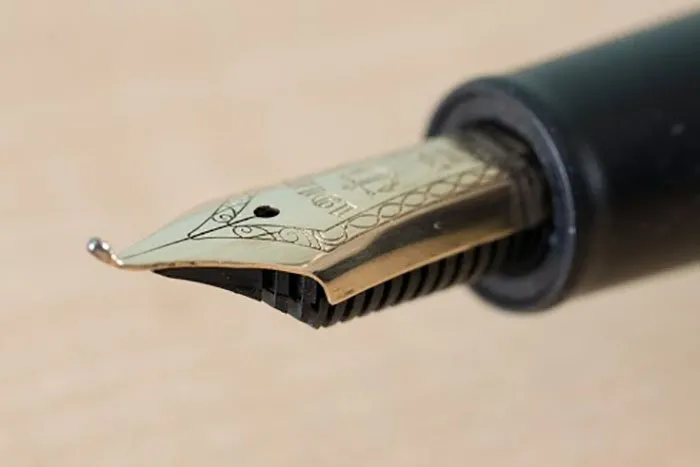
Mistake seven - not keeping the nib upright
Last but not least, the seventh fountain pen mistake is not keeping the nib up when you travel. Especially when you're in a plane, the cabin pressure changes over time and if your nib faces down, or if it's horizontal, chances are ink is pushed outside of the pen and either you get a stain on your jacket or the next time you open your pen, all of your fingers are going to be full of ink. Now a good ink is very colour fast so you can't just go to the bathroom and wash it off, you'll have ink stains on your fingers for a few days, which is a very memorable mistake so once you make it, you won't make it again. So what should you do, always keep the pen with the nib up and you'll be just fine and don't have to worry about ink leaking or ink stains on your fingers.Overall, you have to pay a little more attention to a fountain pen and you have to be a little more deliberate than with a ballpoint pen or a roller ball. On the other hand, a fountain pen enhances your handwriting and the look of it in a way no roller ball or ballpoint can compete with.
Ask us anything, and we'll reply as soon as possible
Our friendly online customer support team will answer your questions seven days a week.
